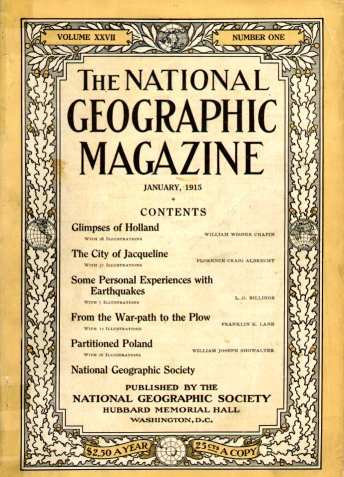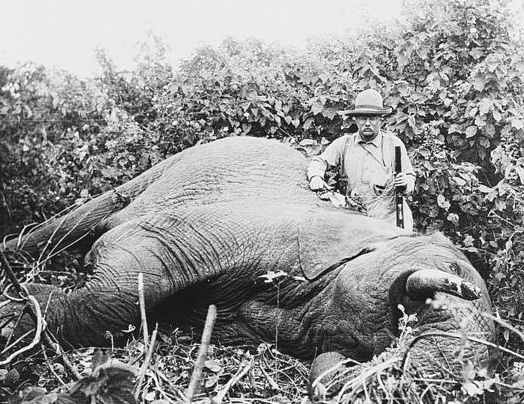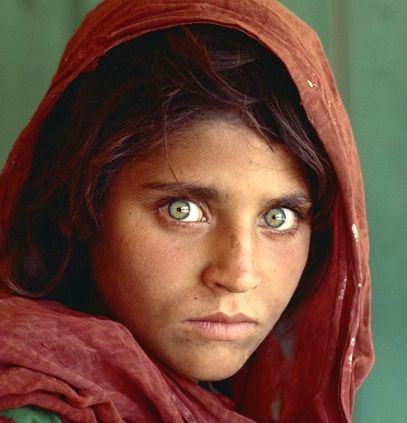|
NATIONAL GEOGRAPHIC SOCIETY
|
|
|
HOME | BIOLOGY | FILMS | GEOGRAPHY | HISTORY | INDEX | INVESTORS | MUSIC | NEWS | SOLAR BOATS | SPORT |
|
|
The National Geographic Society, which is based in the United States, is one of the world's largest not-for-profit educational and scientific organizations, with a mission to advance the general knowledge of geography and the world among the general public. To this end, it sponsors and funds scientific research and exploration, and publishes as its official journal, the magazine National Geographic, as well as other publications and products in furtherance of its mission. It also has heavy involvement in education, including an educational foundation furthering geography education.
Cover of January, 1915 National Geographic
Founding
The National Geographic Society was founded in the United States on January 27, 1888, by 33 men interested in "organizing a society for the increase and diffusion of geographical knowledge." They had begun discussing forming the Society two weeks earlier on January 13, 1888. Gardiner Greene Hubbard became its first president and his son-in-law, Alexander Graham Bell, eventually succeeded him.
National Geographic Magazine
The National Geographic Magazine, later shortened to National Geographic, published its first issue nine months after the Society was founded. It has become one of the world's best-known magazines and is immediately identifiable by the characteristic yellow border running around the edge of its cover. This distinctive yellow border is a registered trademark of National Geographic.
There are 12 monthly issues of National Geographic per year, plus occasional special edition issues. In addition to being well-known for articles about scenery, history, and the most distant corners of the world; the magazine has also long been recognized for its book-like quality and its standard of photography. This standard makes it the home to some of the highest-quality photojournalism in the world. The magazine began to feature color photography in the early 20th century, when this technology was still rare. During the 1930s, Luis Marden (1913-2003), a writer and photographer for National Geographic, persuaded the magazine to see the benefits of using the small 35mm cameras loaded with the new Kodachrome film over the bulky cameras with tripods and glass plates that were being used by the magazine's photographers at the time.
The magazine is also well-known for frequently providing detailed maps of regions that are visited. The Society's map archives have even been used by the United States government in instances where its own cartographic resources were limited. In 2001 National Geographic released an eight-CD-ROM set containing all its maps from 1888 to December 2000.
Theodore Roosevelt next to dead elephant on his safari for the National Geographic Society in 1910
Subscribers to the magazine frequently keep old issues (most other magazines tend to be discarded after a household uses them), and subscribers can get special cases to contain each yearly volume.
During the Cold War, the magazine committed itself to presenting a balanced view of the physical and human geography of nations beyond the Iron Curtain. The magazine printed articles on Berlin, de-occupied Austria, the Soviet Union, and Communist China that deliberately downplayed politics to focus on culture. In its coverage of the Space Race, National Geographic focused on the scientific achievement while largely avoiding reference to the race's connection to nuclear arms buildup.
In 1959, the magazine started publishing photographs on its covers, which had previously contained only text. In subsequent years, the magazine shed its famous oak leaf trim; the outer yellow border, however, has become a solid icon and trademark of both the magazine and Society.
One cover photo in 1985 was of an Afghan refugee, a young girl with piercing green eyes. Her image became world famous. After the US-led invasion of Afghanistan a search was conducted for the girl. She was identified in 2002 as Sharbat Gula, a Pashtun. Her story was told in the April 2002 issue of National Geographic and in a National Geographic television documentary. A special fund in Sharbat Gula's name was created and originally funded by the Society and contributed to by thousands of readers which resulted in the creation of a girls' school in Afghanistan that taught hundreds of teen-age girls with both a vocational and basic education, in addition to a hot meal and health care. The funds also contributed to the construction of a public school for girls in Kabul.
In 1995, National Geographic began publishing in Japanese, its first local language edition. The magazine is now published in thirty (30) different language editions around the world, including: English on a worldwide basis, Bulgarian, Chinese, Croatian, Czech, Danish, Dutch, Finnish, French, German, Greek, Hebrew, Hungarian, Indonesian, Italian, Japanese, Korean, Norwegian, Polish, Portuguese, Romanian, Russian, Slovenian, Spanish, Swedish, and Turkish.
In contrast to the United States, where membership in the National Geographic Society was until recently the only way to receive the magazine, the worldwide editions are sold on newsstands and via regular subscriptions.
In April 2005, an Indonesian edition began, published by Gramedia Majalah - Jakarta. A Bulgarian edition of the magazine launched in November, 2005.
Other publications
In addition to its famous flagship magazine, the Society publishes four other periodicals:
The Society previously published:
The Society has also published maps, atlases, and numerous books.
Sharbat Gula as seen in the photo used for the 1985 issue of National Geographic
Television
The National Geographic Society has also explored the use of television as a way to bring the travels of its correspondents and its educational and scientific mission into people's homes. National Geographic specials as well as television series have been shown on PBS and other networks in the United States and terrestially globally for many years. (The Geographic series in the U.S. started on CBS in 1964, moved to ABC in 1973 and shifted to PBS in 1975.
The over-the-air specials have become almost as identifiable with the society as the magazine. Over the years, they have introduced Americans to famous science icons from Louis Leakey to Jacques Cousteau. The specials' theme music by Elmer Bernstein, also adopted by the National Geographic Channel, has become one of the most famous in American broadcasting.
In 1997 internationally and in 2001 in the United States, the Society launched, in part ownership with other entities like News Corporation and NBC, television network, the National Geographic Channel (NGC) for cable and satellite viewers, which has global distribution.
National Geographic has also expanded into feature films, producing a feature film based on the diary of a Russian submarine commander starring Harrison Ford in K-19: The Widowmaker, and most recently retooling a French-made documentary for U.S. distribution with a new score and script narrated by Morgan Freeman called March of the Penguins.
Support for research & projects
The Society has helped sponsor many expeditions and research projects over the years, including:
The Society sponsors many socially-based projects including AINA, a Kabul-based organization dedicated to developing an independent Afghan media.
The Society also sponsors the National Geographic Bee, an annual geographic contest for American middle-school students. Every two years, it conducts an international geography competition. The most recent was held in Budapest, Hungary during the summer of 2005.
Hubbard Medal
The Hubbard Medal is awarded by the National Geographic Society for distinction in exploration, discovery, and research. The medal is named for Gardiner Greene Hubbard, first National Geographic Society president.
The Hubbard Medal has been presented 33 times in the past. Recipients include polar explorers Robert Peary in 1906, Roald Amundsen in 1907, Capt. Robert Bartlett in 1909, Sir Ernest Shackleton in 1910 and Richard E. Byrd in 1926; aviators Charles Lindbergh in 1927 and Anne Morrow Lindbergh in 1934; anthropologists Louis Leakey and Mary Leakey in 1962; Apollo 11 astronauts Neil Armstrong, Edwin Aldrin and Michael Collins in 1970; anthropologist Richard Leakey in 1994; conservationist Jane Goodall in 1995; underwater explorer Robert Ballard in 1996; and balloonists Bertrand Piccard and Brian Jones in 1999.
Flag of the National Geographic Society
External links
A taste for adventure capitalists
Solar Cola - a healthier alternative
|
|
|
This
website
is Copyright © 1999 & 2012 NJK. The bird |
|
|
AUTOMOTIVE | BLUEPLANET | ELECTRIC CARS | ELECTRIC CYCLES | SOLAR CARS |



